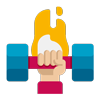The average person weighing 180 pounds burns 669-857 calories per hour playing Hockey, the calories burned depends on the your weight, and the intensity of the activity.
Hockey is an intense sport that is played by men, women, and children of all ages worldwide. To be an elite hockey player, you must be in top physical shape if you want to compete with the other players. Read on to find out exactly how many calories you can expect to burn while playing various forms of hockey.
Hockey is a sport that can be played in different forms on a variety of surfaces with equipment that depends on which form of hockey you are playing. You can play hockey on ice, pavement, turf, or grass fields.
Some hockey games make use of ice skates, wheel skates, or normal turf shoes and cleats. No matter which form of hockey you are playing, the objective of the game remains the same.
Hockey involves an object (such as a puck or ball) that players attempt to hit, shoot, or direct into the opponent’s net in order to score points. The team with the most points at the end of the game is the winner, with the possibility of overtime if the score remains tied at the end of regulation.
As we mentioned, hockey can be played recreationally or competitively by everyone. There are even para ice hockey leagues where those with physical disabilities can participate in the sport. No matter what type of hockey you are playing, there is an intense amount of physical exertion required to succeed at the game.
Level Up Your Fitness: Join our 💪 strong community in Fitness Volt Newsletter. Get daily inspiration, expert-backed workouts, nutrition tips, the latest in strength sports, and the support you need to reach your goals. Subscribe for free!
Hockey is also played at the Olympic games among the best players in the world. Field hockey and ice hockey typically draw in a significant amount of viewership in addition to the other events at the Olympics.
No matter which type of hockey you’re playing, you can expect to burn plenty of calories since you are constantly moving. In fact, many hockey players only play for a short amount of time and then come off the play area for a break before going back into the game.
How To Use The Calculator
Using the calculator to determine how many calories you’ll burn while playing hockey is easy and only requires a few steps. To calculate the number of calories that you’ll burn, just input your weight and the time that you’ve spent or plan to spend playing hockey. Then select the type of hockey activity you’re participating in and hit CALCULATE.
Using the calculator step-by-step:
- Choose your unit of measurement (pounds or kilograms)
- Enter your weight in the corresponding unit of measurement
- Find the specific hockey activity that you’re playing
- Enter the time (in minutes) you are playing hockey for
- Hit “CALCULATE”
How the Calculator Works
Our calculator uses MET values to give you an accurate estimate of how many calories you can expect to burn while playing hockey and doing other activities. The higher the MET value, the more calories you will burn.
MET (Metabolic Equivalent of Task)
MET stands for metabolic equivalent of task, and MET values allow us to give you an estimated expenditure of energy for many different activities, such as playing various forms of hockey.
A MET value is a ratio between the working metabolic rate and the resting metabolic rate [1], which is the rate of energy that is used relative to the duration of time spent playing hockey.
So a MET value of 1 is the equivalent of the amount of energy you expend while at rest, and a MET value of 7 means you are expending 7 times as much energy compared to being at rest.
Almost all activities that you can think of have MET values assigned to them. Some activities with MET values are common, and some are not so common. For example, there are MET values assigned to activities like painting, mowing the lawn, and even skydiving!
Most activities come with varying levels of intensity and have different MET values assigned to them. For instance, playing field hockey has a different MET value than playing ice hockey.
Formula
The formula that our hockey calculator uses to determine the number of calories burned per minute is (MET x bodyweight in Kg x 3.5) ÷ 200.
Examples
A person weighing 180 pounds will burn approximately 666 calories per hour from playing field hockey. This activity has a MET of 7.8, which means that it burns over seven times as many calories as you do at rest.
This is what the formula for calculating the calories burned while playing field hockey will look like for a 180-pound individual at a MET value of 7.8.
- Calories burned (per minute) = (body weight in kg x MET x 5) ÷ 200
- Calories burned (per minute) = ( 81.6 x 8 x 3.5 ) ÷ 200
- Calories burned (per minute) = 1 calories x 60
- Calories burned (per hour) = 666 calories per hour
Another type of hockey that you can play is ice hockey. This form of the game is played on a large sheet of ice and requires players to have developed skills in skating in addition to the objectives of the game of hockey.
This is what the formula for calculating the calories burned while playing ice hockey at a competitive pace will look like for a 180-pound individual at a MET value of 10.
- Calories burned (per minute) = (body weight in kg x MET x 5) ÷ 200
- Calories burned (per minute) = ( 81.6 x 10 x 5 ) ÷ 200
- Calories burned (per minute) = 3 calories x 60
- Calories burned (per hour) = 858 calories per hour
The Hockey
Hockey-like games have been depicted in various different forms across many cultures in history, such as in Egypt, Greece, and Ireland before the Common Era. Hockey started to evolve into the sport we know today throughout the 19th century when national and international organizations sought to regulate and standardize the game of hockey.
Hockey can be played any time of year in a variety of different venues. The sport can be played outdoors at the park or a high school field, or it can be played indoors at a stadium or arena. Hockey is most popular in the United States, Canada, Sweden, and Russia, and many of the world’s elite players come from these countries among others.
Level Up Your Fitness: Join our 💪 strong community in Fitness Volt Newsletter. Get daily inspiration, expert-backed workouts, nutrition tips, the latest in strength sports, and the support you need to reach your goals. Subscribe for free!
The most popular types of hockey include:
- Ice hockey
- Field hockey
- Para ice hockey
- Roller hockey
- Street hockey
Each form of hockey involves different types of movement and different ways of navigating the playing field or rink. Due to the various movements required to play the game, hockey is a great form of exercise whether it’s being played for fun or competitively.
What Muscles Does Playing Hockey Work?
When you think of the sport of hockey, you may believe that it only involves your lower body. However, every form of hockey is a total-body workout that is strenuous. Only players in top physical shape can play the game of hockey at the professional and Olympic levels.
Hockey is a great core workout and it’s actually underrated in the amount of strength that you need in your core to be a great hockey player. Having a strong core offers stability, balance, and power when you’re skating and running in the different forms of hockey. The main core muscles that are used when playing hockey include the obliques and rectus abdominis.
Hockey also works your lower body as well. With every skating stride or sprint from a hockey player, you are generating power with your quads and adductors. You also rely on your hamstrings and glutes to generate speed and also slow down when it comes time to switch directions.
You are also required to use your forearm muscles, biceps, and triceps in order to shoot the ball or puck in any type of hockey. Ice hockey players shoot wrist shots and slap shots that require a great deal of strength. Some hockey players can shoot the puck or ball at speeds of over 100 miles per hour.
Benefits of Playing Hockey
First and foremost, hockey is a great form of exercise that burns plenty of calories no matter how long you play the game. Playing hockey with friends or on a team will develop your endurance and you’ll soon be able to play hockey for longer periods of time without taking many breaks.
Since you burn a significant amount of calories while playing hockey, it is a great way to lose weight. Combining regular hockey sessions with a balanced diet and remaining in a caloric deficit each day allows you to lose weight at an accelerated pace.
Hockey is also a great way to build strength. The core and leg muscles are being developed on every movement that you make when you’re playing hockey. The upper body muscles get toned with all the shooting that you do when you play hockey.
Some non-physical benefits of hockey include building teamwork and better communication skills. Hockey requires players to communicate on different formations and various plays that the team practices. You can also play hockey in a recreational league that encourages socialization with other players before and after the game.
Lastly, hockey improves hand-eye coordination due to the focus that it takes to be able to swing the hockey stick and shoot the ball or puck into the net.
Equipment
No matter what type of hockey you participate in, you will need plenty of equipment to ensure that you play the game safely and at a high level.
The first piece of equipment that you need to play hockey is a stick. Depending on which type of hockey you are playing, you will need to purchase different types of sticks. There are special sticks for field hockey and ice hockey players. The goaltender or “goalie” typically uses a different type of stick than the other players.
If you’re playing ice hockey, you will need ice skates that are specifically designed for hockey players. You will also need plenty of padding due to the physical nature of hockey that involved body checking and taking hits from other players’ hockey sticks.
All hockey players need some type of face mask or headgear to protect themselves from the pucks or balls that are shot at high speeds. Hockey players also wear protective padding like shin pads on their lower body to ease the blow of hits that they sustain from play.
Frequently Asked Questions:
Does hockey get you in shape?
Hockey, whether played on ice or on a field, is a sport that offers a total-body workout that includes both aerobic and anaerobic elements. The fast-paced nature of the sport provides aerobic exercise, while the reliance on all of the body’s major muscle groups also makes it an anaerobic activity. This makes hockey a great way to get in shape while having fun.
How much of a workout is hockey?
There’s no doubt that at the elite level, hockey is an intense workout. Characterized by short bouts of high-intensity skating that feature quick changes of speed and direction, players typically play for 15-22 minutes during a 60-minute game. Shifts last from 30-80 seconds followed by four to five minutes of recovery.
Is hockey good for cardio?
Hockey is an intense cardio workout. You’re out there on the ice, sweating under pounds of heavy equipment, heart racing, eyes darting every which way, and skating like your life depends on it. It is a game of skill, speed, and coordination. You can expect to get a substantial cardio workout from playing hockey for even just a short period of time.
Do hockey players need to be flexible?
Changing directions and being able to maneuver quickly around other players is a key skill in all types of hockey. Players need to be flexible and agile to be successful at the game of hockey. Increasing one’s flexibility helps to maintain stability and balance, which is also important for injury prevention while playing hockey.
The Bottom Line
Hockey is a physically demanding sport that can be a great way to burn calories, lose weight, and meet other hockey players who share similar interests.
Be sure to invest in the necessary hockey equipment to play the game safely and at the highest level possible. Playing hockey recreationally is the most common form of the game, which allows people of all ages and skill levels to play and enjoy one of the most popular sports in the world.
Use our hockey calculator to get an idea of how many calories you can expect to burn while playing hockey, and be sure to check out all the other calculators that we have to offer at Fitness Volt!
References:
- Jetté, M., Sidney, K., & Blümchen, G. (1990). Metabolic equivalents (METS) in exercise testing, exercise prescription, and evaluation of functional capacity. Clinical cardiology, 13(8), 555–565. https://doi.org/10.1002/clc.4960130809




















